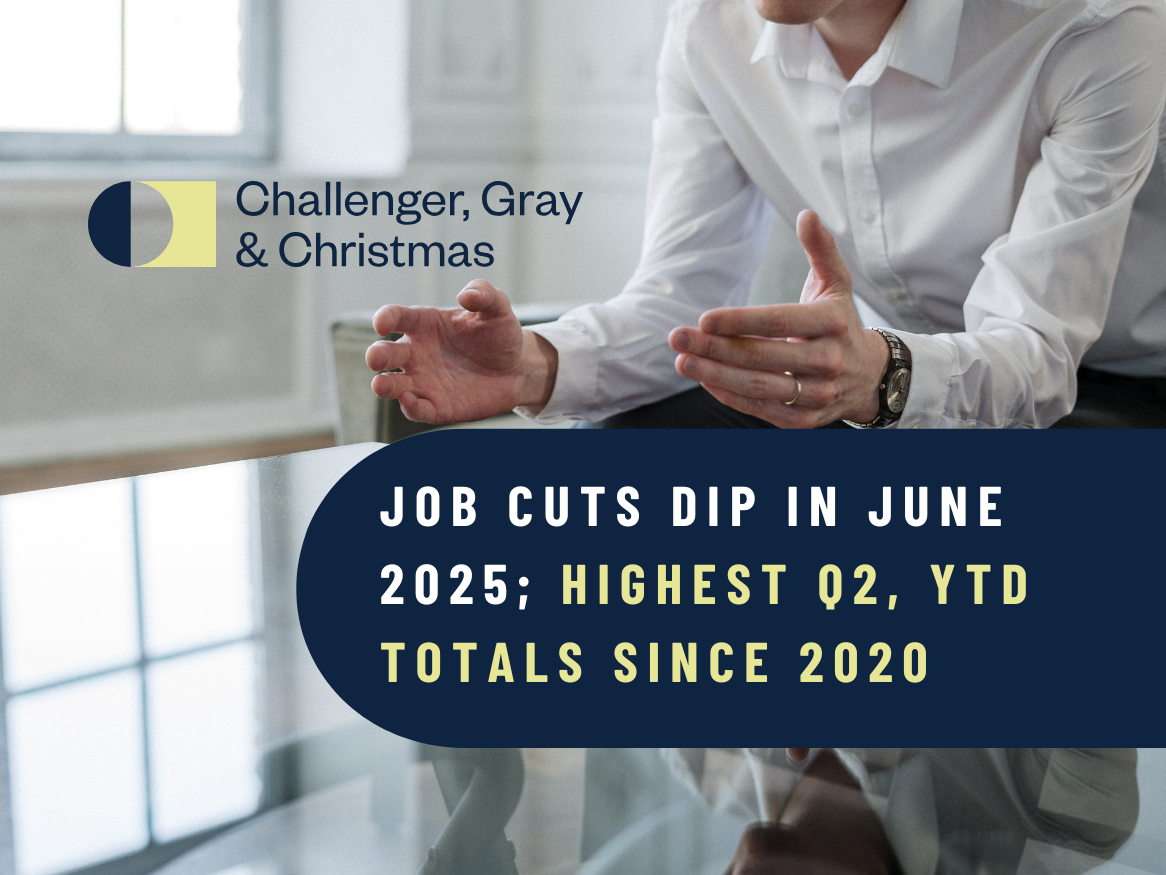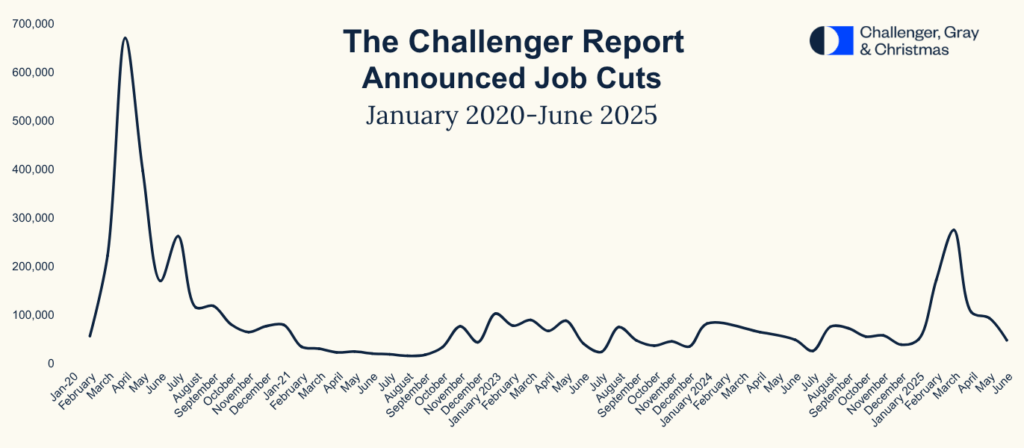
Jul 02 Summer Lull in June 2025 as Companies Announce Virtually the Same Number of Cuts as Last Year; Highest Q2, YTD Cuts Since 2020
Published July 2, 2025
U.S.-based employers announced 47,999 job cuts in June, down 49% from May’s 93,816. It is down 2% from 48,786 announced in the same month last year, according to a report released Thursday from global outplacement and business and executive coaching firm Challenger, Gray & Christmas.
The second quarter saw 247,256 job cuts, the highest Q2 total since 1,238,364 cuts announced in 2020. It is up 39% from the 177,391 cuts announced during the second quarter last year. It is down 50% from the 497,052 cuts announced in Q1.
“The bulk of companies cited economic conditions last month. We saw some DOGE activity and have tracked over 2,000 jobs directly attributed to tariffs this year, but for the most part it was a quiet June,” said Andrew Challenger, Senior Vice President and labor expert for Challenger, Gray & Christmas.
So far this year, companies have announced 744,308 job cuts, the highest YTD since 2020 when 1,585,047 were announced. Outside of 2020, it is the highest YTD since 896,675 cuts were announced in the first six months of 2009.
WHICH INDUSTRIES ARE CUTTING THE MOST IN 2025?
Government
In June, the Government cut 3,801 jobs, up 46% from 2,600 in May. For the year, this sector has cut 288,628 jobs in 2025, primarily in the Federal Government, and many of which are in legal limbo.
Retail
Retail is the sector that has cut the most private-sector jobs this year with 79,865, up 255% from 22,467 job cuts announced in the first half of 2024.
“Retailers are one of the hardest hit business sectors by tariffs, inflation, and uncertainty. If consumer spending continues to fall, it could mean more job losses in this industry,” said Challenger.
Technology
Technology has cut 76,214 job cuts this year, up 27% from the 59,854 cuts announced through the same period last year.
“The disruptions in this industry, both from the advancement of AI and the current uncertainties around visas, has cost thousands of jobs this year,” said Challenger.
Non-Profits
Non-profits are being hit hard by losses in federal government funding, rising costs, and ongoing economic uncertainty. So far in 2025, these organizations have announced 16,930 job cuts, a 407% increase from the 3,342 cuts announced during the same period in 2024. The surge is largely fueled by budget reductions at the federal level, which are impacting both direct service providers and affiliated support organizations.
Media & News Cuts
The Media industry has announced 4,752 cuts so far in 2025, down 46% from the 8,750 cuts announced in the first five months of last year.
News, which Challenger tracks as a subset of Media and includes broadcast, digital, and print, has announced 1,139 job cuts so far this year, down 52% from the 2,397 cuts announced during the same period last year.
Lorem ipsum dolor sit amet, consectetur adipiscing elit. Ut elit tellus, luctus nec ullamcorper mattis, pulvinar dapibus leo.
WHY ARE COMPANIES CUTTING IN 2025?
“DOGE Impact” remains the leading reason for job cut announcements in 2025, cited in 286,679 planned layoffs so far this year. This includes direct reductions to the Federal workforce and its contractors. An additional 11,751 cuts have been attributed to DOGE Downstream Impact, such as the loss of funding to private Non-Profits and affiliated organizations.
Market and Economic Conditions are the second-most cited reason for workforce reductions, responsible for 154,126 cuts year to date. This marks a significant increase in economic-driven cuts as companies respond to uncertainty and shifting demand.
Closings of stores, units, or plants led to 107,142 layoffs so far this year, while Restructuring efforts have resulted in 64,487 job cuts. Bankruptcies accounted for another 35,641 layoffs.
Technological Updates, including changes related to automation and AI implementation, have led to 20,000 job cuts in 2025. Of these, 75 were explicitly attributed to Artificial Intelligence, though many companies categorize related changes more broadly.
Other notable drivers of cuts include Cost-Cutting (17,245), Contract Losses (8,893), and Financial Losses (4,909). A total of 18,781 cuts were announced without a specified reason.
WHERE ARE JOB CUTS OCCURING THIS YEAR?
Challenger tracks job cuts by company headquarters location, unless an announcement specifies the geographic location of the layoffs.
So far in 2025, the East region has experienced the largest year-over-year increase in job cuts, surging 222% from 130,768 to 421,330. This dramatic rise is largely due to significant reductions at Federal agencies headquartered in Washington, D.C. The city has 289,586 cuts attributed to it, though many Federal cuts occurred in other cities. Other notable increases include New Jersey, which jumped from 5,403 to 23,138 cuts (a 328% increase), and New York, which rose 42% from 51,696 to 73,405. Meanwhile, some states saw sharp declines: Connecticut dropped from 7,986 to 1,440 (an 82% decrease), Vermont declined 54%, and Massachusetts fell 32%.
The Midwest region saw a slight overall increase in job cuts, rising 4.1% from 76,159 in 2024 to 79,292 in 2025. However, trends varied significantly by state. Ohio reported a 105% increase, rising from 18,206 to 37,380, and Nebraska surged more than sixfold from 689 to 4,398. On the other hand, Michigan fell 38%, Wisconsin dropped 71%, and Illinois declined by 37%.
In the West region, job cuts remained essentially flat, with a slight decline of 0.7%, dropping from 172,498 in 2024 to 171,241 in 2025. California led the region with 100,084 cuts this year, up 41% from 70,847 last year. Arizona also saw a 40% increase. However, several states experienced sharp drops, including Nevada and Oregon, each down 81%, and Texas, which declined 35%. Washington remained relatively steady with a slight decrease.
The South region reported a 31% increase in job cuts, rising from 55,220 in 2024 to 72,445 in 2025. Georgia posted one of the largest increases, with cuts jumping from 15,861 to 26,656 (up 68%). Florida nearly doubled its total, and Alabama saw a large jump from 2,699 to 6,530. Meanwhile, Tennessee, North Carolina, and South Carolina all saw declines compared to 2024.
HIRING PLANS IN 2025
Through June 2025, U.S. employers have announced 82,932 planned hires, a 19% increase over the 69,920 announced at this point in 2024. While this represents growth, hiring activity remains historically low, particularly when compared to the surge in hiring during the post-pandemic recovery years.
“Hiring announcements are up from last year, which is encouraging. Employers are hiring more cautiously in 2025, likely in response to economic uncertainty and continued cost pressures,” said Challenger.
Year-to-Date Hiring Comparisons:
- 2025: 82,932
- 2024: 69,920
- 2023: 115,462
- 2022: 715,583
- 2021: 551,789
- 2020: 1,336,115
The highest monthly hiring announcement in 2025 occurred in February, with 34,580 hires. Since then, numbers have declined, with just 3,191 hires announced in June, the lowest of the year so far. The monthly average for 2025 is currently 13,822, compared to 64,163 in 2024 and 123,530 in 2022.
“Hiring announcements in 2025 suggest a cautious but stabilizing labor market. While companies are clearly adding workers at a higher rate than in 2024, the restraint shown relative to previous years indicates continued uncertainty around costs, automation, and the broader economic outlook. Without a strong economic driver, hiring may remain measured through the rest of the year,” said Challenger.

